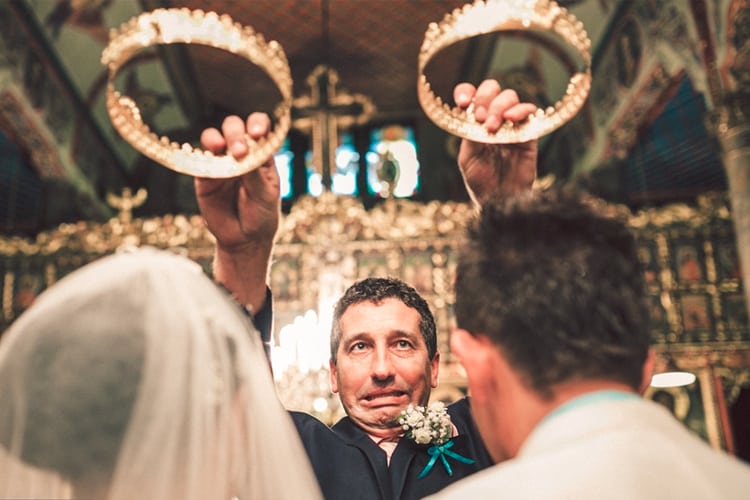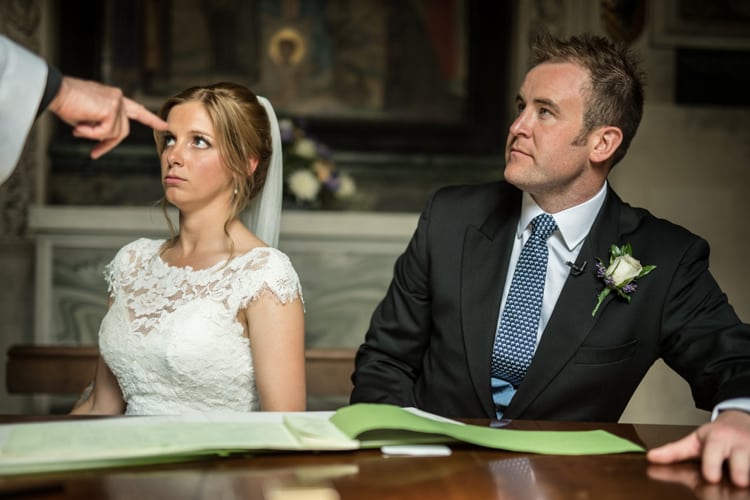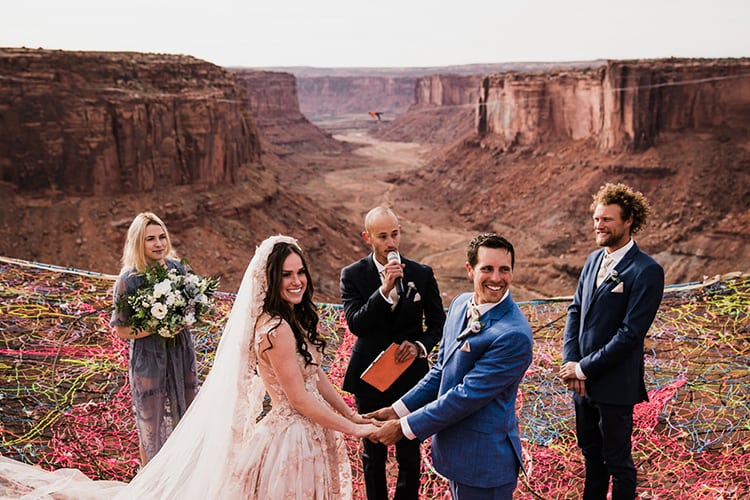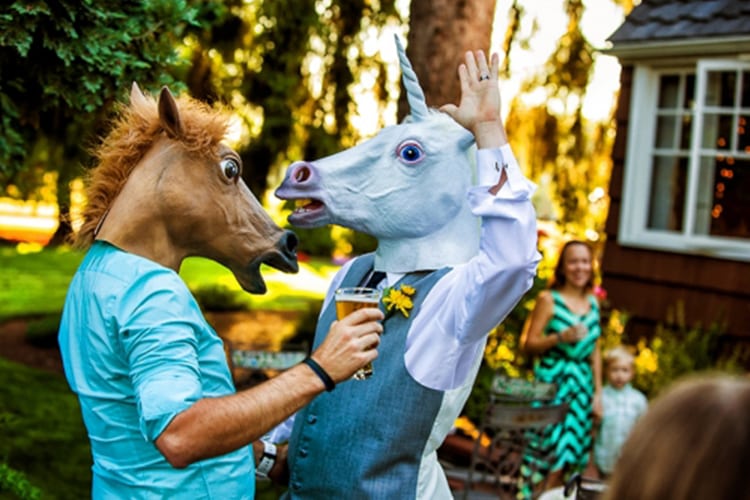
The conventional wisdom from wedding industry is that it’s “your wedding” so choose whatever “formal wear” you please, from a casual navy blazer to a khaki suit to a daring orange tailcoat or traditional Scottish kilt.
Our take? Bad idea. Ignore all that and stick to one guiding principle. WWJBD — What Would James Bond Do? Bond would never tolerate the indignity of getting stuffed into a peach cummerbund. He’d demand simplicity, formality — black.
For those who obsess over latest trends from Milan, a word to the wise: You may go from feeling all set to upset when, ten years down the road, you realize your wedding day look was a product of times, and oh how times have changed. So go ahead and skip over to picking the music for the reception if you please. Everyone else? Closely follow The Plunge’s 18 rules on formal wear.
Rule 1
Pick the best gear for you, but never overshadow the bride
She will undoubtedly “have some thoughts” about how your attire should fit in with the venue and her aesthetic vision for the day. Simply put, find the best formal wear for you, but plan to match your bride’s level of formality and you’ll have no headaches. If she chooses a one-of-a-kind Vera Wang white wedding dress, you wear a classic tux of your choice. If she opts for a lace-trim mini dress from J. Crew, go for a suit or something less formal. If looking stylish in your own right is as important to you as simply avoiding stress (and you’re certainly entitled), then you may have to bring her along slowly, but firmly. The one thing you can never ever do is draw attention away from her because she will make you pay for your transgression. Just look at those hideous dresses she picked out for her friends.
Rule 2
Think long-term: timeless trumps trendy
Ever flip through a wedding album from the ’70s and laugh at the disco ruffled tuxes and leopard-print jackets? If you make any “creative” or “fashion forward” choices that embrace the current trends you will be the punch line in 2044. Memorize that tongue twister: Timeless trumps trendy.
Rule 3
A tux is best. Buy if you can. Rent if you must.
Chances are if you’re getting married, so are a ton of your friends. The tux will pay for itself in three to four events, and if your fiancée can spend $3,000 on a dress she’ll only wear once, why can’t you spend $500 on something you’ll wear repeatedly? Fair’s fair. You might even get someone else to pick up the tab. Of course, if you know you won’t wear those tails again – or you’re a yoyo dieter whose weight fluctuates 30 pounds every other month – then sure, rent the tux.
Rule 4
The groom must always win “best dressed”
If the photographer can’t tell the groom from a groomsman, a guest, his father in law, or a waiter, you’re doing it wrong. Buy that sharp new tux. Go with the tails for something different, yet classy. Accessorize. Break out the new shoes. Outfit your groomsmen so they complement your look without identically matching. Remember, the man who knows how to wear his tux best wins. You’re the groom – be a winner.
Rule 5
Easy on the colors
Black and white. Done and done. Leave the powder blue and orange to Harry and Lloyd and stick to one (not too bright and distracting) pop of color. Your pocket square, vest, or cummerbund is acceptable. Your bowtie is not (see Rule 13) and neither is your tux lining (no one should see it in a well-fitted suit). Note: Colors like “midnight blue” (for tuxes or suits) and “charcoal” (for suits) fall into the category of black and white. Welcome to the insanity of fashion. Bonus Pro Tip: Midnight blue works best with lighter hair and will actually appear darker than black at night because as everyone knows, midnight is darker than regular night. You are now fashionable.
Rule 6
The only acceptable suit is your best suit
Before we get into the details, we should note that yes, a suit can work. You should still look different yet complementary to your groomsmen (think pinstripe or pattern vs. solid color), remember not to compete with your bride, and it had better fit like it’s your very best quality suit. We’d recommend dark navy or charcoal if you go this route. Solid or stripe is up to you. Your bride will appreciate it if your tie incorporates the wedding’s color scheme. Jesus. Did we just say “wedding’s color scheme?” Slap us.
Rule 7
Find a good tailor
And for that matter, find a good retailer that offers classic tailoring. Chances are you will need something altered, whether it’s tapering the trousers, shortening the jacket sleeves or adding a buttonhole to the lapel. Sure, you might have to pay for it, but if this is to be your best suit it should look like it. If you already use someone else for your suits then by all means go there. If not, ask around for recommendations. Chances are your fiancée already has a tailor on her list of contacts.
Rule 8
Find the right cut and fit for your body
Alright men, let’s suit up. First and foremost, certain cuts and combinations work better for different body types. The highlights:
Short and slender: Single breasted jacket, mid-sized lapel.
Short and stocky: Wider collar lapel, absolutely no cummerbunds. One-button tuxedo or top button of a suit should fall on the natural waist, not above it, to product a longer lapel line.
Tall and muscular: Classic single-breasted (or double-breasted if cut well) can complement this physique.
Tall and slim: Pretty much anything. Classic single-breasted is probably best, double-breasted will also work (always button it up).
Finally, fit matters. If the jacket almost fits but you think maybe you can squeak by without alteration, pony up the 40 bucks to slim down the shoulders. You always look better in a properly fitted suit or tux, whether you have the physique of Tony Romo or Tony Siragusa.
Rule 9
Know your lapels – peak is best
Most tuxes out there today feature notch lapels, which sadly leave many grooms looking mass-produced and undistinguished because they just don’t know any better. Well know this: it’s passable for the daytime, but for a formal nighttime affair (and in general, really) peak lapel is the best choice and is worth the effort potentially required to find one. Not only is it dressier, it’s more elongating. Also note: the broader your shoulders are, the wider your lapels should be.
Rule 10
Your collar’s scale, height, and spread must flatter your face
When choosing a collar, always consider your face and its proportions. The wing collar (with points shooting up) is the most traditional, but if you, like Bond, wouldn’t be caught dead in one, there are other options. For a round face, go for a more vertical straight-point collar. For a long neck, you’ll need a higher-sitting collar. When in doubt, try it on and choose the collar whose scale, height, and spread is the most flattering for your face. Or just have your bride decide. As for the shirt itself, go as plain as you can stand. You need not ruffle – just make sure it fits.
Rule 11
With respect to tradition, ditch the pleats
When you begin to question whether timeless really trumps trendy, recall that in the ‘80s and ‘90s pleated pants were trendy. You may be more comfortable pleated , and in certain cases (aka those tall, slim guys mentioned above who look good in everything, dicks) they may make you look more stylish and elegant. If that’s your prerogative, go with god. Generally, though, plain front pants are the risk-free choice. And while we’re talking trousers, formal pants never have cuffs. Your pant legs should break slightly on top of your shoe and angle slightly downwards – try on your pants with your dress shoes for a perfect fit. No Thom Browne walking in floodwater ankle cleavage, please.
Rule 12
On shoes: new, black, and broken-in
First, buy a new pair of shoes. Simple design, black, thin sole – almost like a slipper. The classiest option is a black leather pump with a box. If that’s a little too Sex and the City for you, a plain-toed black lace-up or slip-on in patent leather, velvet suede, or a well-shined matte finish works just fine. If you wear tassels, we reserve the right to ambush your wedding and sucker-punch you in the heart. Keep the Jordans on Instagram. And repeat after us: no wingtips! Next, and most important, break them in well before the wedding. Do not skip this step. You will be standing all night – comfort is key.
Rule 13
Bowties – we’re gonna need a bigger rulebook
There are way more rules than a stupid little tie should require, but hear are the basics if you do go with the box. First, learn in advance how to hand tie it (a dying art). Second, match your tie’s fabric to your lapel (grosgrain to grosgrain, satin to satin – you get it). Third, make it black. The bowtie is meant to frame your face. White leaves a shapeless void, colors make you look like you’ve been gift-wrapped, and matchy-matching your colored bowtie and cummerbund like some Garanimals catalog reject warrants a swift roundhouse kick in the brain. If you must, a white pique bowtie is reserved for a tailcoat and wing collar only – never with a dinner jacket/tuxedo. Also, the tie goes in front of the collar wing thingies, because bowtie etiquette.
Rule 14
Accessorize with purpose
Suspenders: With a vest or cummerbund, suspenders are essential – they keep your pants on your waist at the ideal height of a properly sitting vest or cummerbund. In other words, wear suspenders or else pants fall down go boom. If you’re not wearing a vest or cumberbund, make sure your suspenders offer some contrast with your white shirt so as not to compete when you ditch the jacket.
Pocket Square: And we do mean square (fold). Linen is more conservative and easier to fold. Silk is festive and flashy but more cosmetic – a puff fold works. Whatever fits your personality (or bride’s prerogative).
Cufflinks: Keep on keepin’ it Bond. Simple silver or gold to match your studs and watch metal. Also can’t ever go wrong with onyx. And let your tailor know you want to show a little cuff.
Watches: Sorry, Panerai fans. Either wear a classic-sized watch that matches your other bling, or leave your wrist bare. Big faces are distractions from brides’ faces.
Boutonniere: Make sure you get your left lapel buttonhole opened by a tailor (if needed) and maybe snag a boutonniere loop to keep the sucker in place. Otherwise, this falls under flowers and flowers belong to the bride.
Rule 15
Cummerbunds have their place
Yes, we warned against the old-fashioned ruffled tuxedo shirt. (“I don’t want to be a pirate!”) However, in the case of the cummerbund, there is actually purpose beyond tradition. Your waistband shouldn’t be exposed, and the cummerbund hides your last shirt button and suspenders while smoothing over your tucked-in shirt. Plus, it was actually designed to hold opera tickets in the up-facing pleats, so it’s a handy holder for all those checks. If you’d rather go with a vest, we say potato/potato. Both can add an individuality factor with different colors or textures. On the other hand, both can add the train wreck factor with random colors and even more random textures. When all else fails, have your bride decide.
Rule 16
Don’t mindlessly follow the rules
They’re more like guidelines, anyway. Seriously, learn these rules and bend them to your personality and style. Frankly, the man who knows the rules is the man most likely to play with them, because knowledge breeds confidence and confidence breeds learned individuality. All the rest is nothing more lasting than opinion and guesswork. This is why Bond is unequivocally Bond. (However, if your learned individuality means a top hat and tails,* you damn well better know what you’re doing.)
*This is actually still a classy look today (and the silhouette that best accentuates your body), but only your grandpa will get it.
Rule 17
Relax: your clothes just have to fit
Plus 17 other rules have to be followed, but seriously. People won’t notice your thread count; they’ll notice your bride. They’ll whisper about her dress, swoon over her hairstyle, and gush about her overall beauty. (Or they’ll bitchily snicker about her shortcomings. You’ll never know.) Listen to your bride, follow our advice – timeless over trendy, black, and classic – and as long as your clothes fit well, your work is done.
Rule 18
Less is more
Think of “fashion boldness” like salt. A little will add some flavor; a lot will spoil the dish. If your entire ensemble is classic – simple jacket, pants, and tie – then you can add one spicy element (a crimson flower boutonnière, say) and it will pop. If do you go the “less is more” route, through, just make sure your “less” is authentic and stylish. If not, “less” can be boring, unflattering, and ultimately, like it’s wearing you. The bottom line: Knowledge trumps everything.
And thus concludes your official Groom Duties.

















